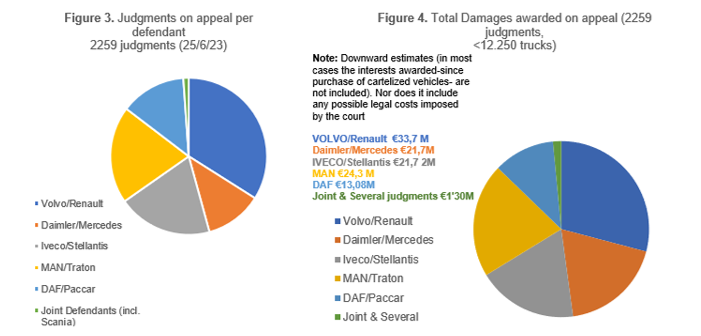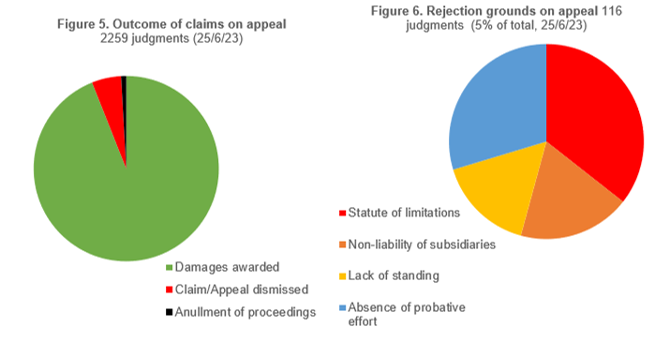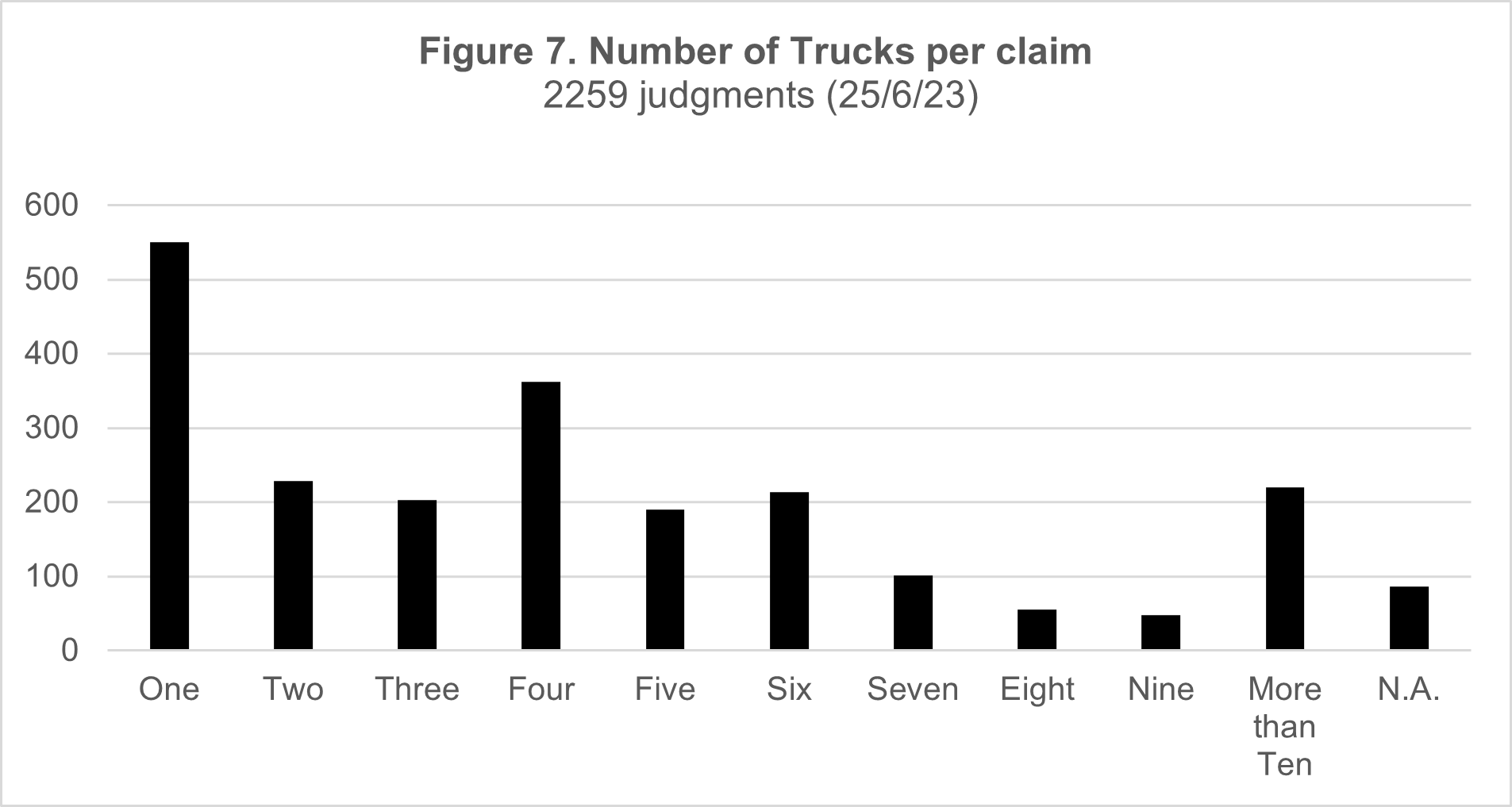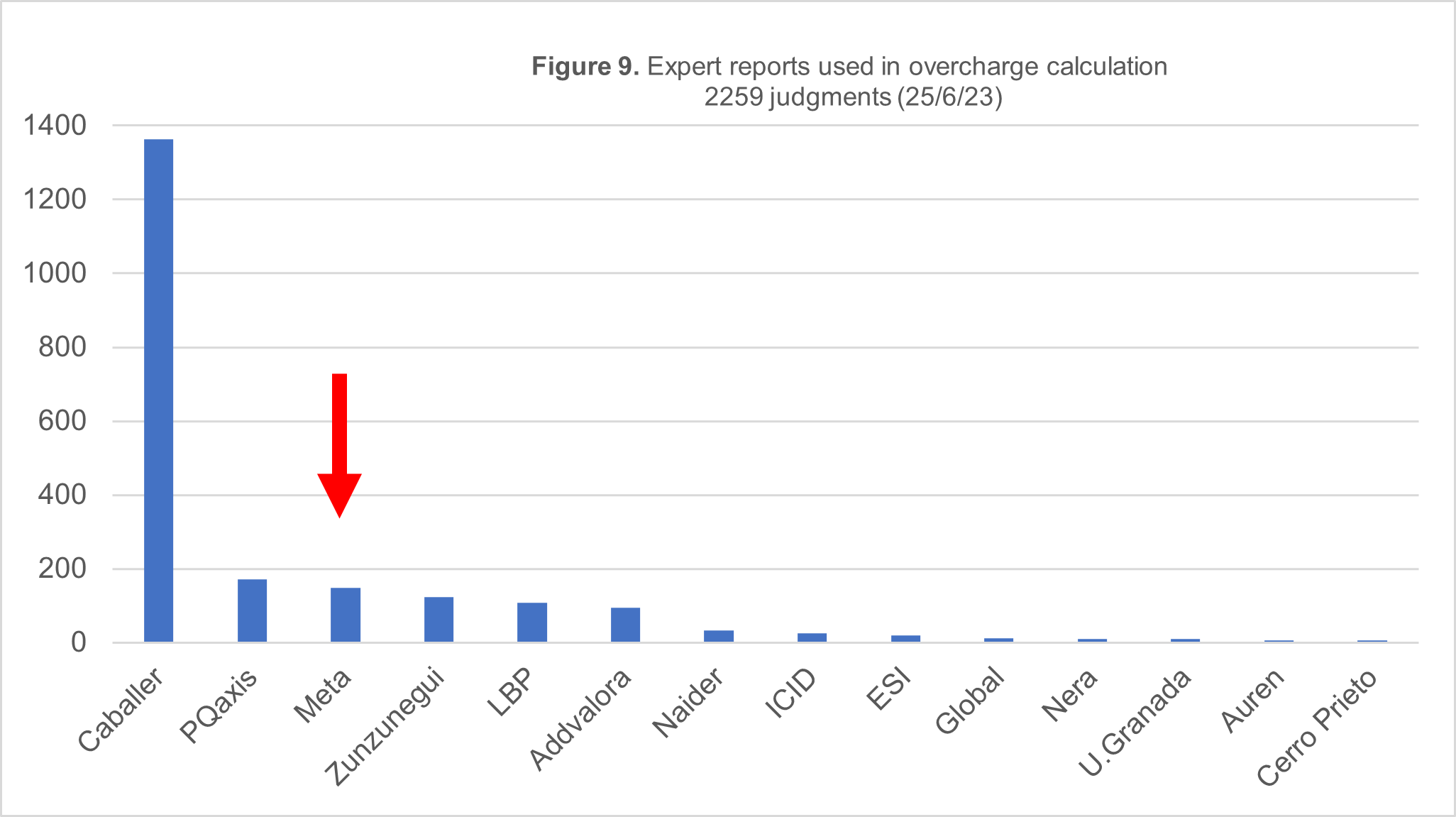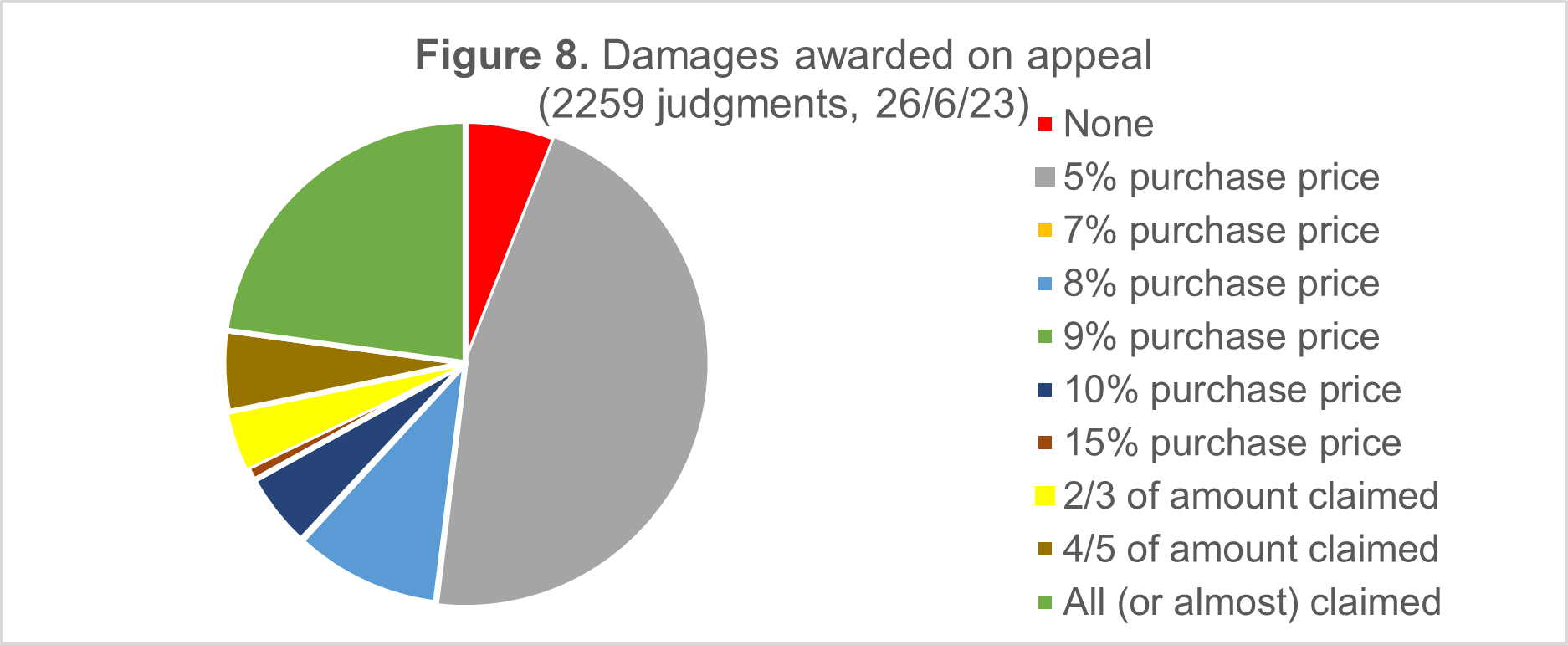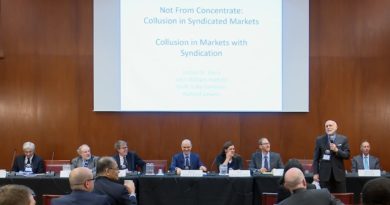The Spanish Supreme Court Sentences the Trucks Cartel
Introduction
Three weeks ago, the Spanish Supreme Court delivered its first rulings on damages claims in the trucks cartel. Given that Spanish courts have been the most active in the EU on this case (see the stream of judgments issued by the Courts of Appeal in Figure 1, 85% are available at CENDOJ
Before the Spanish Supreme Court, only the German Supreme Court had ruled on the case in three judgments (KZR 35/19
Fifteen judgments of the Spanish Supreme Court
The fifteen judgments of the Supreme Court were decided in appeals filed against judgments of five Court of Appeals (Barcelona, Pontevedra, Valencia, Vizcaya, and Zaragoza), which in all -but two cases (ES:APV:2020:3547
Table 1. Supreme Court judgments on trucks cartel damages claims
The judgments resolve the first appeals that reached the Supreme Court against judgments handed down by the Courts of Appeal in late 2019 and early 2020.
Most of the judgments appealed come from the Court of Appeal of Valencia (8/15), which on the path of the groundbreaking judgments of commercial court 3 (Eduardo Pastor, see ES:JMV:2019:34
On the other hand, as Table 2 shows, in comparison with the share of the total judgments per defendant that have been delivered on appeal, in the Supreme Court judgments Iveco/CNH is over-represented, and Volvo/Renault is under-represented. Figures 3 and 5 illustrate the share per defendant of the total number of judgments (Figure 3) and the damages awarded against them (Figure 4).
Table 2. Defendants in Supreme Court judgments on trucks cartel damages claims
Defendants’ appeals
Most of the appeals before the Supreme Court were initiated by defendants, although they were joined by claimants in five appeals. Fourteen of the defendants’ appeals, based both on procedural and substantive grounds, were rejected. In addition, and not a trivial issue, defendants were ordered to pay the costs in nine appeals. Only one of the defendants’ grounds of appeal -concerning the quantum of damages- was partially accepted (ES:TS:2023:2475
Claimants’ appeals
Two of the five claimants’ appeals were accepted, with the cases being sent back to the appeal court to rule on them again (as the judgments that declared them time-barred were quashed, ES:TS:2023:2474
Given that article 74 of Spanish Competition Act
On the other hand, although the dies a quo in damages claims following-on a final Decision of the European Commission is now crystal clear (in the trucks cartel after CJEU judgment C-267/20 Volvo & DAF
Apart from those two judgments that focus solely on the limitation period (and which should lead soon to two new rulings of the Valencia Court of Appeal surely mirroring what the Supreme Court held in the other cases – the circumstances therein present being the same), the rest of the Supreme Court judgments endorse the unanimous holding of the appealed judgments: claimants have a right to damages based on a judicial estimation of the cartel overcharge. As will be explained below, in the circumstances present in these proceedings, the Supreme Court confirmed the judicial estimation of the overcharge at 5% of the price of the cartelised vehicles.
“First wave” of claims…
The Supreme Court declares this initial batch of judgments decide the “first wave of claims” of the trucks cartel damages litigation in Spain. This temporal reference seems to be borrowed from the Competition Appeal Tribunal (CAT), that named “first wave proceedings” those that were first transferred by the High Court of England and Wales (see [2022] CAT 41
Any parallel with the trial and management of the proceedings in the CAT is however limited: the “wave” metaphor aptly describes the progressive and sequential management of proceedings in the CAT as a first instance court, whilst the Supreme Court is the highest court in Spain, and well over 2.000 appeals crowd its docket. Rather than “waves” in the trucks cartel damages litigation, the Spanish Supreme Court seems to be facing a tsunami.
In my view, by referring to them as the “first wave of claims”, the Court is pointing to the litigation being in its infancy and emphasizing the limitations claimants faced in the early stages when the lawsuits were filed. This is relevant, as in deciding some matters, the Court will consider the specific circumstances present when the claims were filed (“in view of the state of the matter and the litigation at the time it was submitted”” ¶24 of ES:TS:2023:2492
More than 5.000 judgments on the merits have been issued by over a hundred Spanish commercial judges at first instance and over 2.300 judgments have been issued on appeal by forty-six provincial courts. So far, courts of appeal have awarded damages in 95% of the judgments (Figure 5). At the appeal level, only 5% of the claims have been rejected, mainly for being time-barred (Figure 6).
The “first wave” of appeals in the Supreme Court have in common that they all were addressed to a single defendant (infringer or a Spanish subsidiary), the manufacturer of the trucks in each case. Contrary to what has occurred in other jurisdictions, and despite the absence of any obstacles to claiming compensation to the infringing manufacturers for trucks they did not manufacture, in Spain these types of claims have been infrequent (see, e.g., ES:APV:2021:170
In addition, all the claims decided by the Supreme Court involved a small number of cartelised trucks (seven of them involving only one truck), totaling 149 trucks. In contrast with the large and collective claims that have been started in other jurisdictions (although the three judgments decided by the German Supreme Court involved 24 trucks: in KZR 35/19
It is a straightforward preliminary observation that the Supreme Court has mostly confirmed the rulings by the Courts of Appeal. In endorsing the lower courts’ decisions, the Supreme Court repeated that it does not want to become a “third instance” decision-maker. Rejecting all the appeals filed on procedural grounds (mostly by defendants), it asserted that if the rulings by Courts Appeals are sufficiently grounded law, are properly reasoned, and do not reach irrational conclusions, it is not willing to revoke or quash them.
Naturally, each of the judgments resolves the specific procedural and substantive grounds of appeal in each case, but all of them share a common structure (with many paragraphs repeated) concerning the legal regime applicable, the harm caused by the trucks cartel sanctioned by the Commission Decision AT.39824
Apart from several references to its own case law and constitutional law judgments on due process, the judgments are peppered with references to the European Commission Practical Guide to the Quantification of Antitrust Harm
Before we turn to some of the salient issues addressed by the Supreme Court, overall, it is worth stressing that the Supreme Court follows the path taken by the lower courts, strengthening the arguments concerning the victims’ right to compensation.
Law applicable ratione temporis
In confirming the appealed judgments, the Supreme Court definitively resolved the issue concerning the legal regime applicable in these claims. Endorsing the rulings of the Courts of Appeal, the rules adopted in transposition of the substantive rules of the Antitrust Damages Directive (Decree-law 9/2017
Subsidiary liability
Five judgments address the liability of one of the infringers’ subsidiaries (CNH Industrial N.V.), which had been considered jointly liable by the Courts of Appeal despite the fact they were declared infringers for a short period of time (17 days) by the Commission (ES:TS:2023:2492
In another judgment (ES:TS:2023:2476
Binding Effect: The trucks cartel according to the Spanish Supreme Court
Furthering the unanimous understanding of Courts of Appeal, based on the evidence provided by Decision AT.39824
Harm and causality
The Supreme Court rebuffed the defendants’ arguments that the cartel did not cause harm to the truck purchasers. Despite the brevity of the Commission decision, the Court confirmed that it is correct to presume from the Decision that an overcharge was paid in purchase of trucks (“The facts from which the appellate court presumes the existence of the damage and the causal link are the facts found in the Decision” par. 6.6 of ES:TS:2023:2492
Arguments put forward by defendants to support their position that the cartel had no effect were rejected as considered either to have an incorrect basis or to be unplausible (including the passing-on). In particular, borrowing from the Amsterdam District Court judgment of 11/5/21 (C/13/639718/HA ZA17-1255 et al
“It is not understood why the intermediate levels of the market (the national subsidiaries in charge of distribution and the dealers, whether independent or dependent on the manufacturers) would have absorbed in their commercial margins for 14 years the gross price increases caused by the unlawful conduct of the manufacturers, thus avoiding their repercussion on the final purchasers” (par 6.11 in fine of ES:TS:2023:2492
Although the Supreme Court avoids explicitly endorsing the presumption of harm ex re ipsa that some Courts of Appeal had declared in their judgments, it emphasized that the trucks cartel was an “extremely severe infringement of competition law”. Following article 386 of the Spanish Civil Procedure Act
Finally, in two judgments, the Supreme Court further held that the pernicious effects of the cartel in the purchase price of trucks extended beyond the “official” end date of the cartel on 18/1/2011 due to a “lag effect” (par. 10.25 of ES:TS:2023:2480
Calculating the amount of the cartel overcharge
As in any antitrust damages claim, calculation of the amount of the cartel overcharge is difficult, given the need to estimate what would have been the price absent the infringement. In deciding upon the damages claims in the sugar cartel the Supreme Court had already cautioned about this: any calculation made is inaccurate due to the “impossibility of perfectly reproducing what the situation would have been had the unlawful conduct not occurred” (ES:TS:2013:5819
In the trucks cartel, the features of the cartel make the calculation of the overcharge very difficult (“very serious difficulties in the quantification of the damage”, par. 4.4 of ES:TS:2023:2472
Use of meta-data studies to calculate harm?
In every claim, but one (ES:TS:2023:2497
However, it should be noted that some Courts of Appeal, notably Madrid (e.g., ES:APM:2021:14305
This was surely the eagerly anticipated ruling by the Supreme Court, concluding that in the cases at hand, “taking into account the specific circumstances of the dispute“, there was not a failure of the claimant to provide evidence, so the gate to judicial estimation was opened. That conclusion was grounded in a systematic and teleological interpretation of article 101 TFEU and the need to ensure its effectiveness, which implies broadly that anyone harmed by an infringement of the prohibition of cartels and other anti-competitive agreements should be able to claim damages (par. 6. 22 of ES:TS:2023:2492
Temporal argument
When the suit was filed it was unclear if statistical analysis was valid/sufficient for calculating the cartel overcharge. It was repeated in several instances in the various judgments: “in view of the state of the matter and the litigation at the time it was submitted”” (par. 6.24 of ES:TS:2023:2492
Somehow the Supreme Court acknowledged the lack of sophistication of claimants at the early stages of the trucks cartel damages litigation. Although the courts rejected promptly the use of an extrapolation from statistics/metadata studies as a basis for the claimants’ damages petition, the suits were filed “when these judicial assessments denying the effectiveness of statistical methods to assess specific damages caused in the purchase of a vehicle affected by the cartel had not yet become widespread” (par. 6. 20 in fine of ES:TS:2023:2492
One of the justices deciding the cases had very recently reflected on the retrospective bias:
“Ex post, once an event has occurred, without realizing it, we tend to exaggerate its predictability ex ante. Uncertainties are invisible in retrospect.” (Ignacio Sancho “El arte de juzgar y las dificultades para encontrar la solución más justa” in Acto de Investidura del Grado de Doctor Honoris Causa
In that contribution, Justice Sancho referred to such risk in assessing retrospectively the “inventive step” requirement in Patent law. Transferring his reasoning here, would suggest that if the expert activity is examined retrospectively, there could be a viewpoint that the inadequacy of an overcharge calculation based on a extrapolation from metadata studies was obvious when the lawsuit was filed (i.e., expert activity cannot be judged ex post facto, an effort must be made to put oneself in the shoes of an average expert with the knowledge that existed in the state of the art at the time of the filing of the lawsuit).
The reference to the “retrospective bias” is striking and does not seem to hold true: when the claims were filed it was clear that metadata studies were not apt for calculating the amount of the cartel overcharge in specific cases. The European Commission’s Practical Guide to the Quantification of Antitrust Harm
Economic argument
The costs of access to evidence (including documents in foreign languages) and experts needed to make an adequate calculation of the overcharge may be disproportionate in relation to the damages claimed (“Disproportion that would make the plaintiff’s legal claim clearly uneconomical“, par. 6.21 of ES:TS:2023:2492
At first sight, given the modest amounts claimed, the resources available for hiring economic expertise for the calculation of the harm were rather limited. In half of the claims decided here the overcharge claimed was caused by the purchase of one cartelized truck, with the amounts claimed being well below €20.000. The Supreme Court extended this argument when the claimant was not a self-employed or a small firm, as in ES:TS:2023:2475
Looking at the limited sums at stake in most of these disputes, it is easy to agree with the view that, individually considered, most of the claimants in the cases before the Supreme Court would have found the costs of the elaboration of an adequate expert report as non-economical (see table 3, interest excluded, not in those amounts with *).
| Case nº | Number of Trucks | Amount claimed (€) | Amount awarded on appeal (€) | Amount awarded by the Supreme Court (€) |
| 923/23 | 1 | 17.358,46 | 3.985 | 3.985 |
| 924/23 | 1 | 6.694 | 1.834 | 1.834 |
| 925/23 | 3 | 40.325,92 | 9.735 | 9.735 |
| 926/23 | 1 | 18.068,14 | 4.582 | 4.582 |
| 927/23 | 17 | 151.946 | 105.546,92 | 36.182,31 |
| 928/23 | 1 | 12.270 | 0 | (4.086,88) |
| 939/23 | 1 | 14.314,90 | 0 | (4.057) |
| 940/23 | 1 | 13.605 | 1.450 | 1.450 |
| 941/23 | 2 | 24.005,04 | 8.704,57 | 8.704,57 |
| 942/23 | 2 | 72.814,11 * | 20.878,82 | 20.878,82 |
| 946/23 | 6 | 67.471,61* | 13.880,97 | 13.880,97 |
| 947/23 | 108 | 1.298.115,35 | 128.623,18 | 128.623,18 |
| 948/23 | 2 | 36.087,34* | 8.225 | 8.225 |
| 949/23 | 1 | 21.176,31 | 3.542,50 | 3.542,50 |
| 950/23 | 2 | 43.652,60 | 7.885,95 | 7.885,95 |
Table 3. Amounts claimed and awarded in cases decided by Supreme Court
In my opinion, this argument is more persuasive than the temporal argument, highlighting the need to protect claimants from the potential inefficiencies and limitations that might arise from the rules governing civil procedure in Spain. However, it ignores the fact that practical solutions were available to claimants and their lawyers (claim bundling and resources pooling). More problematic still is the fact that, contrary to the temporal argument, the economic argument would apply to more than half of the trucks cartel litigation in Spain, given that 60% of the claims involve the purchase of less than four trucks, with implications for other cases (namely, and probably with even more substance, to thousands of individual claimants in the automobile cartel).
Judicial estimation of the overcharge
To overcome the difficulties faced in the calculation of harm in antitrust damages litigation, the Directive recognizes the explicit power of courts to estimate the amount of harm (article 17.1 implemented as article 76.2 of Spanish Competition Act
The Supreme Court considered that such power already existed previously in domestic law as an extension of the right to compensation in tort infringements (article 1902 of Spanish Civil Code
In any case, given that the meta-data study presented by claimants has been considered unconvincing (both by the Courts of Appeal and the Supreme Court), the Supreme Court endorsed the judicial estimation of the overcharge at 5% of the price of the cartelised truck as minimum compensation. Only in one case (ES:TS:2023:2475
Future waves: above or below the floor of 5% of the price of the cartelised truck
The Supreme Court repeated several times that the judicial estimation of harm at 5% of the price of the cartelised truck is a “minimum”, in the context of the partial evidentiary value present in the cases that were decided now.
It is worth recalling that lower courts had arrived at that figure as the most “conservative” estimate of the overcharge taken from the “lower end” of the range of cartel overcharges on the basis of the OXERA report (Quantifying antitrust damages towards non-binding guidance for courts 2009
In endorsing the lower’s court judicial estimation of the overcharge in these cases, the Supreme Court introduced further ideas that may help in ascertaining the way ahead for the appeals that it will need to decide soon.
For the Supreme Court, the very description of the cartel that enabled the judicial presumption of harm, also indicate “that the harm was not insignificant or merely symbolic” (par. 6.24 of ES:TS:2023:2492
On the other hand, given that only 7% of Courts of Appeals’ judgments ruled on claims calculating the overcharge as the weighted average extracted from meta-studies (see Figure 9), it is still unknown how the Supreme Court will decide on appeals against judgments in which the claimants’ presented a proper expert report for the quantification of the cartel overcharge.
Nevertheless, the Supreme Court judgments include a few reminders to its early jurisprudence (ES:TS:2013:5819
On one hand, the Supreme Court is clear in stating that a damages award exceeding the minimum of 5% is possible if the claimant proves that the overcharge was higher than that. On the other hand, it also considers the possibility that defendants could present an alternative overcharge calculation, lower than the minimum of 5% (par. 6.24 in fine of ES:TS:2023:2492
In the only two cases in which the defendant (Volvo/Renault) had presented an expert report which tried to calculate the overcharge, the Court recalled that the possibility of showing an alternative harm calculation is also open to defendants (“the mere fact that an expert’s opinion on antitrust damages […] may result in the quantification of the damage at a very low value, or even show a value of 0, cannot by itself automatically disqualify its evidentiary value” par. 9. 23 ES:TS:2023:2479
The Court explicitly affirmed that the quantification could be 0 but, in my opinion, this assertion is rather rhetorical, as it seems to contradict the Court’s own interpretation of how the trucks cartel operated and its effects on the market. Instead, it is more plausible that, using adequate and sufficient data (which KPMG did not use in the two cases referred, only utilizing prices for the 2003-2016 period), that a low overcharge was shown. For this purpose, the Court acknowledged that defendants’ data can be used in the calculation, considering that they “are relevant and adequate to be integrated in the analysis of the ham quantification“, as long as their selection was not flawed “by the application of biased criteria that could influence the results obtained from its analysis and affect its reliability” (par. 9.23 ES:TS:2023:2479
In practice, moving away from the minimum floor will depend on the Courts’ assessment of the expert reports presented by the parties. Obviously, this idea is consistent with the general rules on the burden of proof in Civil Procedure,
It seems safe to assume that the Supreme Court will keep confirming the judgments of lower courts, as it has repeated in its judgments its unwillingness to review the assessment of the expert reports conducted by them unless there was “manifest error or arbitrariness” (par. 3.2 y 3 of ES:TS:2023:2478
Compared to the cases decided in the “first wave”, in other judgments to be reviewed in the future, Courts of Appeal had estimated overcharges higher than 5% of the purchase price of the truck (see figure 8). That is something that the Supreme Court explicitly contemplates, but what is relevant then is to analyze the reasoning that had led the lower courts to varying estimations of the harm.
Firstly, from what the Supreme Court has ruled, it can clearly be concluded that damages claims based on a extrapolation of metadata studies cannot exceed the floor of 5% (mainly ES:TS:2023:2475
Secondly, the fact that the Supreme Court set a minimum overcharge estimation for damages claims based on an extrapolation from metadata studies does not imply that the same estimation should apply in cases when the claims were based on proper expert reports. Therefore, as a matter of principle, and subject to the discussion below, it is possible that in other cases, if the expert report presented is deemed to have some evidentiary value, an overcharge above the 5% threshold may have been estimated.
In practice, that mean that there could reasonably exist diverse estimations and damages awards, and the Supreme Court may tolerate them, if the reasoning in lower courts’ judgments is not irrational or unjustified. Indeed, a similar situation occurred in the damages’ litigation in the envelopes’ cartel, where the Supreme Court implicitly approved a divergent assessment of the same expert report -and, subsequently, varying damages awards- by the Courts of Appeal of Madrid and Barcelona (cfr. ES:APM:2020:1
Thirdly, the relative consensus of the lower courts and the Supreme Court on awarding a minimum estimated overcharge of 5% for damages claims based on an extrapolation from meta-studies simplifies that most Courts of Appeal have tended to project the same conservative estimation across the board to each and every case presented, independently of the different evidentiary value of the claimants’ reports. In fact, the 5% minimum estimation has become the average estimation, for every claim, as a sort of “consolation award” in 46% of the cases decided on appeal to date (all judgments in favor of claimants in Córdoba, Girona, Guadalajara, Lugo, Navarra, Orense, Pontevedra, Tarragona, Teruel, Toledo, Valencia, Vizcaya and Zamora).
At first glance, it could seem reasonable that the overcharge estimation would be equal for every claimant but, in my opinion, this understanding of the principle of equality is neither a requirement of the law nor coherent with incentivizing claimants’ efforts to present adequate evidence to the court. It rather promotes a mistaken idea of equality and propagates a false sense of legal certainty. Each claimant must reap the reward of what they have sown. This view (which I have defended in Almacén de Derecho 22/11/22
Fourthly, at the same time, to make things even more difficult, some expert reports had been considered fully convincing by some lower courts but not by others (both at first instance and at the appeal level), due to mistakes and inaccuracies, which had led the later to reduce the damages awarded (claims based in the Addvalora, Caballer, LBP, Nera and PQAxis reports are prime examples). In that situation, it seems necessary that the Supreme Court will need to rule on these diverse assessments of the same expert reports by lower courts, because the divergences are based on a different interpretation of the requirement that, to be accepted and found convincing, any expert report quantifying the harm would need to provide “a reasonable and technically founded hypothesis based on verifiable and non-erroneous data“. In my view, it is not feasible that such contradictory assessment of the probatory effectiveness of the same expert valuation can coexist.
Interests
The Supreme Court judgments on this matter follow closely the case law of the CJEU that had interpreted the principle of effectiveness and the right to compensation of aggrieved parties as requiring that the payment of interest from the moment that the harm occurred is necessary as “a measure aimed at ensuring full compensation for the harm suffered by the victim of the infringing conduct of competition law, counteracting the effect of the passage of time between the time of the occurrence of the harm and the time at which the compensation for such harm is agreed” (par. 7.5 of ES:TS:2023:2492
That being said, it is unclear yet what happens when the cartelised trucks were acquired through leasing and the impact that would have on the accrual of interest, as some Courts of Appeal had considered that in those cases harm was experienced with each of the installments paid (see, for example, ES:APZ:2021:1717
Conclusion
After the first fifteen judgments by the Spanish Supreme Court on damages claims in the trucks cartel, the law applicable to these claims and its interpretation have been clarified. As the judgments are final, several issues raised by Spanish trucks cartel damages litigation have been ruled upon by the Supreme Court and they are no longer subject to discussion.
First, in coherence with the design of the appeal procedure in Spanish civil procedure, the Supreme Court judgments show its unwillingness to become a “third instance”, as the judgments handed demonstrates a strong tendency of the top court to uphold the judgments appealed. Furthermore, last week reform of civil cassation
Second, endorsing the unanimous understanding by all Court of Appeals in over 2000 judgments, the Supreme Court has ruled that the trucks cartel had caused damage to truck purchasers. The existence of an overcharge can be presumed from the narrative of the cartel in the Decision of the European Commission. Those aggrieved by the trucks cartel are entitled to compensation of the overcharge paid and interest accruing from the moment of purchase.
Third, when claimants file their suits in court, they should provide a quantification of the overcharge but, in assessing the probatory value of their expert reports, the courts should pay attention to the specific circumstances of each dispute. In this first batch of cases decided by the Supreme Court, damages petitioned were calculated through an extrapolation from statistics and metadata studies on cartel overcharges. Those calculations were found to be unconvincing by lower courts and by the Supreme Court. Still, the Supreme Court has considered that, given the circumstances, even such calculation has some partial probatory value and that courts are enabled to undertake an estimation of the overcharge.
In the cases decided by the Supreme Court, lower courts had conservatively estimated the overcharge at 5% of the purchase price of the trucks. The Supreme Court confirmed the estimation of the lower courts, stressing that the level of 5% is the “minimum” damages award. As a guideline for future cases, it acknowledges that there may be awards above and below that minimum depending on the proof provided by the parties. Pending litigation on the trucks cartel damages in Spain will focus on the quantification of the overcharge along the lines drawn already by the Supreme Court.
_________
* The contributor serves as academic consultant of CCS Abogados, a law firm representing claimants in truck cartel damages actions in Spain, but none of the decided in the judgments here in commented. The author wishes to thank Margarita Alonso-Graña, Lluis Bielsa, Javier Borque, Jaime Concheiro, Juan De la Cruz, Pablo Fuentes, Rafael Fuentes, Javier García de la Serrana, Pedro González, Manuel Martín, Sergio Mencher, Pedro Miralles, Manuel Sánchez and Almudena Vázquez, and some judges for sharing judgments which had not been included yet in the official database CENDOJ



